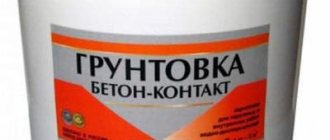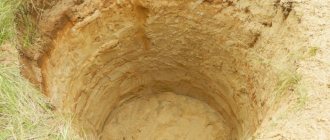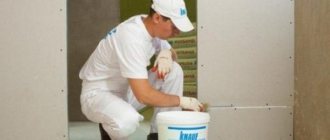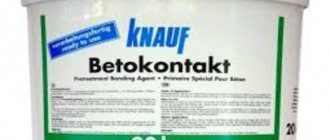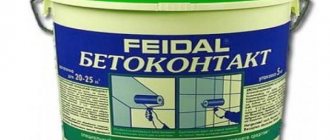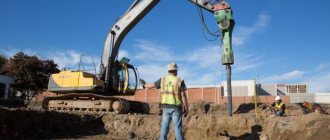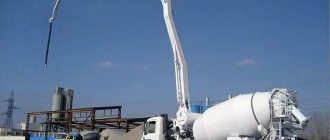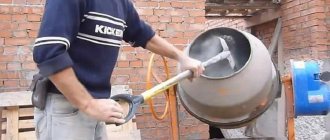In the modern construction market, concrete contact is presented in a wide range. Each manufacturer makes its own changes to the recipe, which affects the characteristics of the material. Let's look at the main differences between soils from popular manufacturers. Let's get acquainted with the features of the composition and subtleties of application. After reading the article, when choosing a concrete contact or working tool, there will be fewer questions for consultants and craftsmen, and the final result will be better.
Original Betokontakt from Germany Source forum.saransk.ru
Specifications
Let's look at what concrete contact is and why it is needed. A popular primer is supplied by almost every manufacturer of paints and varnishes or leveling mixtures. The developers of the composition are recognized as German technologists from the family enterprise Feidal. In the original version, the pink liquid mass is represented by 40-50% solid/dry matter, the rest binding with functional additives.
The technical characteristics of concrete contact are determined by three groups of components:
- acrylic dispersion is responsible for adhesion indicators;
- quartz sand or analogues provide roughness;
- functional additives that give the coating water resistance, resistance to biological or corrosive damage.
Healthy soil has a neutral acidity level. This explains the absence of chemical reactions between the coating and any plaster/adhesive solutions based on a mineral binder, for which concrete contact is more often used.
Mechanical plastering of walls using concrete contact Source specteh-rzn.speczakaz.info
The consumption of primer material directly depends on the size of the solid filler. So, for the most part, the fraction of grains or crystals is 0.3-0.6 mm. The lower the indicator, the less composition will be needed to treat a given area. The dependence also lies in the processed base:
- high-density monolithic/slab concrete – from 350 grams per sq.m;
- tiles, porcelain stoneware – about 150-250 grams/sq.m;
- oil/alkyd paint with continuous coating – at least 200 grams.
To make it easier to monitor the solidity of the coating, manufacturers add pigment additives to the soil. Pink color predominates, blue is less common. The Tex company has found a more original solution - as the composition dries, it begins to turn red on the surface.
Purpose
The scope of application of the soil lies in the information about what it is - concrete contact. The acrylic binder has the ability to penetrate deeply. The composition forms a vapor-permeable rough film. Such properties are valued when working with substrates that do not absorb moisture and have a smooth surface. A common option of this type is concrete.
Smooth concrete floor Source yandex.net
The high adhesive ability of the soil ensures a strong connection of materials. To tear off the coating you will need to apply an average force of 100 g/sq.mm. This suggests that the base treated with concrete contact will be able to withstand a large layer of leveling plaster and cladding.
Among other things, due to the filler and the properties of the acrylic component, the dry residue can strengthen the base. The film has a high tensile strength. This is especially true when finishing an old base with microcracks.
As a result, the scope of application of concrete contact extends to the treatment of surfaces of the following nature:
- high-density concrete (panel houses, columns);
- ceramic tiles for finishing without dismantling the coating (two-layer application of primer is recommended);
- dry wooden base to be plastered (other compositions are not suitable);
- metal structures for any purpose without pre-treatment with an anti-corrosion compound;
- plastic or glass surface with correct calculation of the weight load of subsequent finishing.
Priming a painted surface Source snappygoat.com
See also: Catalog of companies that specialize in finishing materials.
Separately, a primer with sand is considered for suitability for brickwork. Not all manufacturers include such a base in their scope of application. The reason is the heterogeneity of ceramic blocks and grout. The latter refers to porous materials that are rarely permissible to be covered with concrete contact.
Acrylic-based compositions can be diluted with water if necessary (not recommended). After drying, the coating can be painted with dispersion paints. Often the surface is decorated using concrete contact. If the composition is not stirred until smooth, then using a brush you can form a chaotic pattern. This way, you don’t have to align the walls with the ceilings, but you can visually transform it for a long time, and additionally protect it from fungus, mold, and corrosion.
Often in the old foundation, finishers are faced with oil paint and chalk. Such finishing is subject to maximum elimination. Next, you should make notches under the plaster or cladding using an ax or a hammer with a chisel, and sand the surface with a coarse abrasive to create roughness.
Notches on a complex base Source couo.ru
After removing grease stains and dust, priming can be carried out, preferably in two layers with intermediate drying.
Among the recommendations you can find the use of contact concrete under putty. However, this material is intended for thin layer application and finishing. The sand contained in the soil will contribute to the formation of scratches and, in general, the composition will be a waste of time, effort, and money. For final leveling, it is enough to treat the base with a dust-removing agent for plaster, a highly specialized primer for metal, plastic, and glass.
Restrictions on use
Most manufacturers and consultants on trading platforms position concrete contact as a universal material. This applies to any soil regarding the nature of the finish with the base, but not suitability for work indoors and outdoors. Samples applicable in both directions exist, but their number is limited. In fact, some soils cannot be used for treating the facade, roof, or basement.
Primer for interior work Source stpulscen.ru
Some options are only permissible for substrates in dry rooms. It is important to first read the instructions on the labels of the cans or buckets.
Due to the high strength of the film, soil is often used to strengthen a loose foundation, for which concrete contact is unsuitable. The composition will penetrate into pores and microcracks, but only superficially. As a result, the finish may fall off the wall or ceiling in a layer under its own weight. Here you need a special strengthening agent with deep penetration.
In order to enhance adhesion and reduce absorbency, any porous substrates must be treated. Soil with quartz sand is not suitable for this, since the binder component will mostly end up in the pores. As a result, the permeability of the breathable surface will decrease to an insignificant extent, and the bond between the filler grains will be insufficient to withstand the declared mechanical load. The solution here is an impregnating agent, which is applied in 2-4 layers with intermediate drying.
Porous materials Source prom.st
Why is it needed?
When deciding what concrete contact is, it is necessary to take into account the scope and objectives of the finishing material.
The task of the building mixture is to ensure reliable adhesion between the 2 materials and strengthen the base. It is necessary to increase the adhesion rate on the ceiling, wall panels, and when installing ceiling screeds.
The mixture is used for cement-sand and concrete screed. As a result of the work, the coating becomes solid and durable, because scattered layers are aligned.
On wall slabs with a smooth surface and poor water absorption, the solution must be applied before plastering and painting. Without a primer, the materials will not stick, they may crack and crumble, and the wallpaper will not last long.
The mixture allows you to reduce labor costs and the cost of preparatory work for cleaning surfaces of old materials and leveling. After use, the surface acquires the qualities of a waterproofing layer.
Video description
From the video you can get acquainted with the features of various primers:
There are points for which concrete contact is needed, but with limitations. This applies to metal, wood, plastic and glass. The expected result will be obtained only on a mineral surface with the listed inclusions. For a solid base, the option of subsequent finishing with light weight using paints and varnishes would be relevant.
Experts note deviations from the expected when concrete contact is used under self-leveling floors. If you have to work with cement mortar, the adhesion is good, but gypsum does not spread. As a result, cracks and peeling of the coating appear.
Where should you absolutely not use the composition?
Do not use the mixture on substrates with a loose or crumbling texture. The composition is not used when finishing plastered and whitewashed walls, standard fiberboard with a loose texture, foam and aerated concrete, etc.
Experts do not recommend using the composition when installing self-leveling floors, because Cracks may occur, the surface will lift and will not last long.
Errors at work
Due to inexperience or ignorance, building materials for intermediate installation are often used, making mistakes. The consequences of this can be unpredictable, and it is almost impossible to track the processes of destruction under finishing in a timely manner. This also applies to concrete contact.
Consequences of violating plastering technology Source kontrolstroy.ru
In reviews, there is often a remark about adhesives and leveling mixtures that they have poor adhesion to soil with quartz. This is only possible if the solution contains an excess amount of water. This drawback leads to the separation of mixtures due to a disrupted moisture transfer process and a low concentration of the binder component.
Deviations from the declared soil parameters may occur for the following reasons:
- applying the composition at temperatures below +7 – +10°C or above +25°C, at a relative air humidity above 65%;
- processing frozen or wet bases;
- finishing of an unprepared surface (dust, grease stains, affected areas, weak spots);
- inadequate drying of the coating (how long the concrete contact dries depends on the recipe, the original takes only 3-4 hours);
- wind or draft accelerates the process of water loss and the formation of dry residue, but disrupts its quality;
- adding water reduces the concentration of the binder and deteriorates the quality of the adhesive film;
- use of cheap analogues of Betokontakt for “heavy” finishing.
“Heavy” wall cladding with porcelain stoneware Source otdelkino.ru
Dust can be invisible, but it actively sticks to the primed surface. The plaster and glue will peel off from such a base. You will have to do the pre-treatment again.
The solid filler is heavier than the other components in concrete contact. It settles relatively quickly to the bottom of any working container. Therefore, it is important to stir the composition periodically.
The original soil is stored in an airtight container for only 2 years, analogues from six months. Mostly natural ingredients will most likely not cause any harm to health after the expiration date. But quality indicators will noticeably decrease. After sub-zero temperatures during storage, it will be possible to work only with frost-resistant soil. But in any case, it is applied at temperatures above +7 – +10°C to +25°C. This applies to the material, the base and the air.
What to apply?
Before applying the mixture, you need to select the following tools:
- roller;
- wide brush;
- spray gun;
- capacity.
A wide brush allows for an even coating, provides high-quality adhesion to the surface, and corrects cracks and crevices. The tool is used for finishing small areas and beams.
The composition is applied to a painted wall panel or plasterboard floors using a roller. Other tools provide insufficiently dense application for the composition.
Application Tools
The choice of one or another painting tool depends on several points. The main ones are the nature of the building material, the shape, composition and structure of the base, ease of use. Concrete contact is a liquid mass, similar in consistency to kefir, but sometimes a little thicker.
Priming a flat surface with a paint roller Source eyecorrector.ru
A spray gun is also not suitable here because of the hard grain filler.
Since the composition of the concrete contact primer does not include organic solvents, acids, alkalis, or other aggressive components, it is permissible to use tools with any bristles and fur coats by nature. But there are still restrictions.
Soft materials quickly become unusable due to sand. Flat brushes do not pick up much thick mass and do not distribute the filler well over the base. It is more rational to use brushes with hard or medium-hard bristles. In general, it is more difficult to work with a roller for three reasons:
- the grain component is unevenly distributed on the surface;
- solid particles actively scatter over the area depending on the speed of rotation of the roller;
- Short pile and fur take up little soil, while long pile significantly weighs down the tool and splashes more.
As a result, the soil and concrete contact with minimal losses and maximum quality will be applied using a brush with synthetic or mixed bristles.
Distribution of betocontact with maklovitsa Source gidpokraske.ru
In terms of length, it is better to choose medium. It is noticeably easier and faster to work with a roller, but the consumption of the applied acrylic composition will increase, the solid filler will be unevenly distributed, and a lot of debris and splashes will form.
During priming, it is important to protect the skin from betocontact. The same goes for clothes and shoes, if they are not work shoes. Before drying, the composition is easily washed off and washed off. But the splashes and droplets begin to harden after just a few minutes.
After drying, the primer will be very difficult to remove due to its high adhesive ability. The fabric will have to be cut and scraped, but damage cannot be completely avoided. Concrete contact can be removed from the hairline only together with the hair. A rich cream or oil can make the task easier and reduce trauma.
Popular manufacturers
With the use of concrete contact primer, we’ve figured out its basic characteristics, and let’s get acquainted with the distinctive features of compositions from different manufacturers.
Knauf brand soil Source stpulscen.ru
Let’s take the original version of Betokontakt as an example: it dries in 3-4 hours, the consistency is a little thick, the condition is viscous, the filler is fine-grained. Below we consider individual properties of analogues:
- Bolars is too thick, difficult to work with, takes more than a day to dry;
- Olympus - expensive, but not inferior to the original composition;
- Osnovit (Bettokont) - sand settles quickly, dries in up to 2 hours, the manufacturer limits its use only for gypsum solutions;
- Plitonite – the filler is lightweight, so it settles slowly and does not require frequent mixing;
- Pufas – marked by lower adhesion to concrete against the background of Betokontakt;
- Prospectors - dries up to 4 hours, the sand fraction is coarse, which is important for rough leveling finishing and heavy cladding;
- Ceresite is the most common object for counterfeiting.
The German brand Knauf produces relatively inexpensive soil. It has low moisture resistance, so applying liquid solutions is not recommended. In contrast, they put a moisture-resistant sample with marble chips under the Shtock brand.
Akrimax-Lux brand soil Source storg.ru
Briefly about the main thing
Betokontakt is made from acrylic dispersion, fine-grained solid filler, and functional additives.
Almost all manufacturers add pigment additives to the composition to monitor the consistency of the coating.
The main task of the primer is to create good adhesion of solutions with smooth and dense concrete. Additionally, such substrates as ceramic cladding, brickwork, and oil paint are considered. Such surfaces are not always included in the list of acceptable ones for a particular brand of soil.
In the recommendations, you must find out information about the possible use of the material outside and in wet rooms, since not all options are universal.
Consumption
The consumption of concrete contact primarily depends on the size of the sand particles and the condition of the treated surface. If it is too porous and rough, it will require more material than if it is smooth.
Let us give the consumption of concrete contact per 1 m2 for various surfaces:
- For painted walls, metal and glass bases, ceramic tiles, and other smooth and low-porous coatings, 150 g/m2 is required;
- Medium-porous structures made of concrete slabs and finishing bricks will require 300-350 g/m2;
- For very rough substrates such as concrete, building bricks, the consumption rate increases to 500 g or more per square meter.
To reduce costs, for highly porous substrates, conventional deep penetration primers are used, which are much cheaper.
